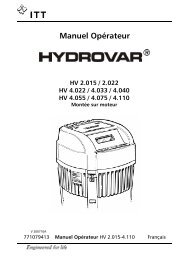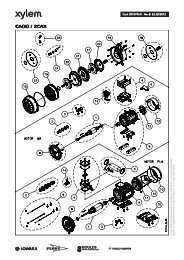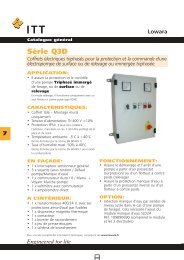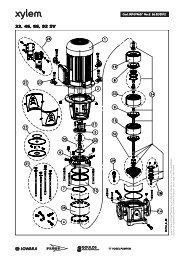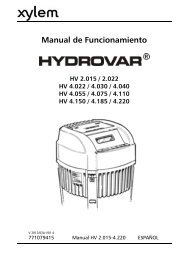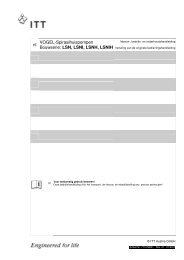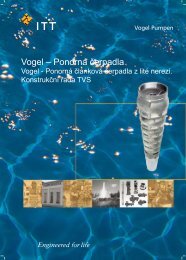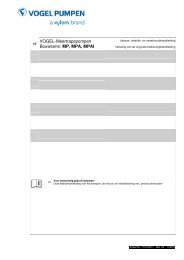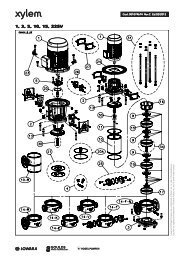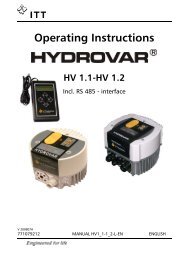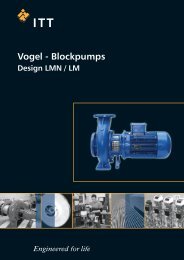Installation, Operation and Maintenance InstructionModel <strong>LSB</strong>Safety instructions attached directly to the pump resp.unit must be followed under any circumstances.Further they must be kept in good readable condition.In the same way, as these Operating Instructionsof the pump, all possibly attached OperatingInstructions of accessories (e.g. motor) must benoticed and kept available.Measures should be taken to exclude any dangerfrom electricity (e.g. by complying with the localregulations on electrical equipment). If work iscarried out on live electrical components, theyshould be unplugged from the mains or the mainswitch turned off and fuse unscrewed. A motorprotection switch is to be provided.2.2 Dangers of non-observance of theSafety InstructionsNon-observance of the Safety Instructions canlead to loss of any claim for damages.Further, non-observance can lead to following risks: Failure of important functions of the machine orfacility. Failure of electronic appliances and measuringinstruments by magnetic fields. Endangering of persons and their personalproperty by magnetic fields. Endangering of persons by electric, mechanic andchemical influences. Endangering of environment through leakage ofdangerous substances.On application of the unit in areas endangeredto explosion special attention must be paid tosections marked with Ex.2.3 Safety Instructions for the Operator /WorkerDepending on the operating conditions, wear andtear, corrosion or age will limit the working life ofthe pump/pump unit, and its specifiedcharacteristics. The operator must ensure thatregular inspection and maintenance are carriedout so that all parts are replaced in good time,which would otherwise endanger the safeoperation of the system. If abnormal operation orany damage are observed, the pump must ceaseoperation immediately.If the breakdown or failure of any system or unitcould lead to people being hurt or property beingdamaged, such system or unit must be providedwith alarm devices and/or spare modules, andthey should be tested regularly to ensure that theyfunction properly.If there is any risk of injury from hot or coldmachine parts, these parts must be protectedagainst contact by the user, or suitable warningsigns must be affixed.Contact protection on moving parts (e.g. couplingguards) must not be removed from systems thatare in operation.If the sound level of a pump or pump unit is above85 dB(A) an ear protection has to be used whenstaying near the pump for some time.If dangerous media (e.g. explosive, toxic, hot) leakout (e.g. from shaft seals), these must be directedaway so that there is no danger to people or theenvironment. The provisions of the law must beobserved.2.4 Safety Instructions for Maintenance,Inspections and Mounting WorkThe operator is responsible that any maintenance,inspections and mounting work is made byauthorized competent personnel, which must beinformed by having read the OperatingInstructions.Basically, all work on the pump or pump unitshould only be carried out when the pump isstationary and not under pressure. All parts mustbe allowed to return to ambient temperature.Make sure that no-one can start the motor duringsuch work. It is essential that the procedure forstopping the system described in the OperatingInstructions is observed. Pumps or pump systemsthat carry media that are dangerous to health mustbe decontaminated before being taken apart.Safety Data Sheets for the various liquids handled.Immediately after finishing work, all safety andprotective devices must be replaced or restarted.2.5 Unauthorized Alteration and SpareParts ProductionAlteration or changes of the machine are permittedafter agreement with the manufacturer.Original spare parts and accessory authorized by themanufacturer are serving the safety.The use of other parts can lead to loss of liability fortherefrom resulting consequences.2.6 Undue OperationThe operating safety of the delivered machine canonly be guaranteed by designated use acc. to thefollowing chapters of the Operating Instructions.The limits stated in the data sheet and / or orderconfirmation must not be exceeded under anycircumstances.2.7 Explosion ProtectionOn application of units in areas endangered toexplosion measures and references in the chapters2.7.1 to 2.7.6 must be observed, so that explosionprotection is guaranteed.2.7.1 Filling of unitDuring operation of the pump the system of thesuction and pressure pipe and the pump itselfmust permanently be filled with the pumpedliquid.Thus, no explosive atmosphere can developand the danger of dry-run is avoided.<strong>LSB</strong> 100-<strong>english</strong> page 74 Revision 02Artikel Nr. <strong>771076129</strong> Ausgabe 01/2010
Installation, Operation and Maintenance InstructionModel <strong>LSB</strong>If the operator can´t guarantee that, accordingmonitoring measures must be provided.Equally all seal casings, auxiliary systems of theshaft sealing, as well as heating and coolingsystems must be filled carefully.2.7.2 MarkingThe marking of the pump refers to the pumpitself. For the motor resp. further additions aseparate Declaration of Conformity, as well as acorresponding marking must be available.Example of of marking at pump:CE Ex II 2 G c T1-T.The marking shows the theoretically applicable rangeof temperature classes. The different temperatures,permitted acc. to pump design, result as shown inchapter 2.7.5. The same is valid for the drive.For a whole unit (pump, motor) with differenttemperature classes the lowest is valid.2.7.3 Rotation ControlIf danger of explosion is also existing duringinstallation, the rotation control must not becarried out by short start-up of the empty pump,to avoid undue temperature increase in case ofcontact of rotating and stationary parts.2.7.4 Operation of pumpThe pump must only be started up with fully openedsuction side and slightly opened pressure side valve.The start-up against closed non-return valve, however,is possible. Immediately after the start-up thedischarge side valve must be adjusted to the operatingpoint.Refer to chapter 6.2, as well.Operation with closed valve in suction and / ordischarge pipe is not permitted!There´s a danger, that high surfacetemperatures are developing at the pumpcasing after relatively short time, through fastheating of the liquid inside the pump.Fast pressure increase inside the pump canlead to overload and, thus, the pump can burst.In chapter 6.4.1 the minimum flow is stated. Longeroperating phases with these flows and the namedliquids don´t cause additional increase of surfacetemperature at the pump.Furthermore the references in chapter 6 of theseoperating Instructions must be taken intoconsideration.On pumps with mech. seals the permittedtemperature limits can be exceeded due to dryrun.Dry run not only can occur on insufficientlyfilled seal casing, but also because of too muchgas in the medium.Operation of the pump out of the permittedoperating range can lead to dry-run, as well.2.7.5 Temperature limitsUnder normal operating conditions the highesttemperatures must be expected at the surfaceof the pump casing and in the area of thebearings.The surface temperature occurring at pump casingcorresponds with the temperature of the pumpedliquid.In the area of lantern and motor free contact ofsurface to environment must be given for propercooling.During operation of the pump it must besecured that an overabundant sedimentation ofdust is avoided (regular cleaning), to preventheating of pump surface over the permittedtemperature.The operator of the plant must secure that thedefined operating temperature is observed. Themax. allowed temperature of the pumped liquid atsuction depends on the particular temperatureclass.The following table shows the theoretical temperaturelimits of the pumped liquid in consideration of thetemperature classes acc. to EN 13463-1.Temperature class acc.EN 13463-1Temperature class acc.EN 13463-1T4 (135°C) 135°CT3 (200°C) 140°CT2 (300°C) 140°CT1 (450°C) 140°CThe particular allowed operating temperature ofthe pump is shown in the data sheet and / or theorder confirmation resp. the type plate at thepump.2.7.6 MaintenanceFor a secure and reliable operation it must besecured by regular inspections, that the unit ismaintained competently and is kept in goodtechnical condition.Example: Function of bearings. Operation andapplication conditions are essentially responsible fortheir achievable life cycle.By regular control of the lubricant and the runningsound the danger of occurring over temperatures bybearings running hot or defect bearing seals isavoided. Refer to chapter 6.6 and 7.4.The function of the shaft sealing must be secured byregular control.If auxiliary systems (e.g. external flushing, cooling,heating) are installed, it must be checked, if monitoringdevices are necessary to secure the function.<strong>LSB</strong> 100-<strong>english</strong> page 75 Revision 02Artikel Nr. <strong>771076129</strong> Ausgabe 01/2010
- Page 1 and 2:
de VOGEL-SpiralgehäusepumpenBaurei
- Page 3 and 4:
Déclaration CE de conformité (val
- Page 5 and 6:
Einbau-, Betriebs- und Wartungsanle
- Page 7 and 8:
Einbau-, Betriebs- und Wartungsanle
- Page 9 and 10:
Einbau-, Betriebs- und Wartungsanle
- Page 11 and 12:
Einbau-, Betriebs- und Wartungsanle
- Page 13 and 14:
Einbau-, Betriebs- und Wartungsanle
- Page 15 and 16:
Einbau-, Betriebs- und Wartungsanle
- Page 17 and 18:
Einbau-, Betriebs- und Wartungsanle
- Page 19 and 20:
Einbau-, Betriebs- und Wartungsanle
- Page 21 and 22:
Einbau-, Betriebs- und Wartungsanle
- Page 23 and 24:
Einbau-, Betriebs- und Wartungsanle
- Page 25 and 26:
Einbau-, Betriebs- und Wartungsanle
- Page 27 and 28: Einbau-, Betriebs- und Wartungsanle
- Page 29 and 30: Einbau-, Betriebs- und Wartungsanle
- Page 31 and 32: Einbau-, Betriebs- und Wartungsanle
- Page 33 and 34: Einbau-, Betriebs- und Wartungsanle
- Page 35 and 36: Einbau-, Betriebs- und Wartungsanle
- Page 37 and 38: Einbau-, Betriebs- und Wartungsanle
- Page 39 and 40: Instructions de montage, de service
- Page 41 and 42: Instructions de montage, de service
- Page 43 and 44: Instructions de montage, de service
- Page 45 and 46: Instructions de montage, de service
- Page 47 and 48: Instructions de montage, de service
- Page 49 and 50: Instructions de montage, de service
- Page 51 and 52: Instructions de montage, de service
- Page 53 and 54: Instructions de montage, de service
- Page 55 and 56: Instructions de montage, de service
- Page 57 and 58: Instructions de montage, de service
- Page 59 and 60: Instructions de montage, de service
- Page 61 and 62: Instructions de montage, de service
- Page 63 and 64: Instructions de montage, de service
- Page 65 and 66: Instructions de montage, de service
- Page 67 and 68: Instructions de montage, de service
- Page 69 and 70: Instructions de montage, de service
- Page 71 and 72: Instructions de montage, de service
- Page 73 and 74: Instructions de montage, de service
- Page 75 and 76: Installation, Operation and Mainten
- Page 77: Installation, Operation and Mainten
- Page 81 and 82: Installation, Operation and Mainten
- Page 83 and 84: Installation, Operation and Mainten
- Page 85 and 86: Installation, Operation and Mainten
- Page 87 and 88: Installation, Operation and Mainten
- Page 89 and 90: Installation, Operation and Mainten
- Page 91 and 92: Installation, Operation and Mainten
- Page 93 and 94: Installation, Operation and Mainten
- Page 95 and 96: Installation, Operation and Mainten
- Page 97 and 98: Installation, Operation and Mainten
- Page 99 and 100: Installation, Operation and Mainten
- Page 101 and 102: Installation, Operation and Mainten
- Page 103 and 104: Installation, Operation and Mainten
- Page 105 and 106: Installation, Operation and Mainten
- Page 107 and 108: Installation, Operation and Mainten



